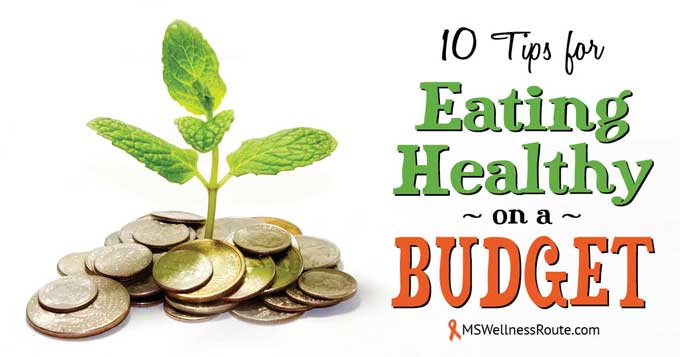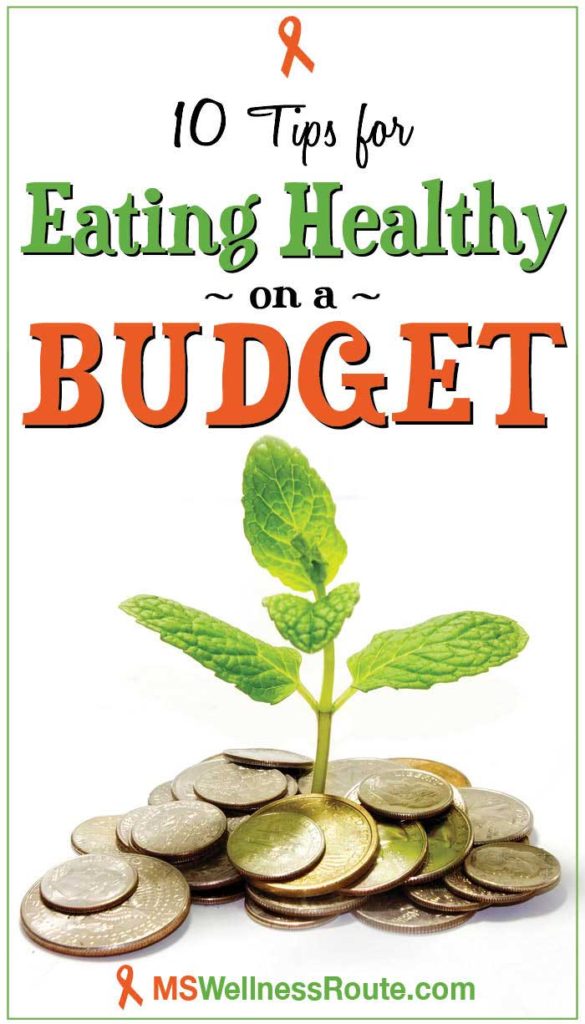Last Updated on January 30, 2025 by Cathy

We all know the importance of eating healthily. But I can’t tell you how many times I’ve heard “I can’t eat healthy because it’s too expensive.” Fortunately, there are many things you can do to help keep the cost down.
According to the Bureau of Labor Statistics, the average American spends $7,729 each year on food. That’s $644 a month for ONE person eating the standard American diet. My husband and I budget $500 each month for eating healthy (it depends on where you live) and that’s for TWO people!
1. Eat at Home
Part of the reason people spend so much money on food is that they eat out four or five times a week. Americans spend an average of $149 each week. Part of eating a nutrient-dense diet means you will be making your own meals and eating at home.
It does take more effort to make something rather than stopping at a fast food restaurant. But home-cooked meals taste much better. Next time you are cooking dinner double the recipe. Use it for lunches or nights you don’t have time to cook or don’t feel like cooking.
2. Plan Your Meals
Planning your meals out for the week can really help you save money. Check to see what is on sale for the week and plan your meals around that. Only purchase enough fresh produce that you will use so you don’t end up throwing away a lot of wilted food.
Before heading to the grocery store decide what you need and how much you want to spend. Some grocers have an app that gives you the price and total cost. It also gives you a dollar amount of how much it will cost before taxes.
3. Make a Shopping List
Impulse buying is kind of fun but it’s also a huge budget buster. If you go to the grocery store without a shopping list you end up spending more money than what you wanted. Making a list before you go and sticking to it will help keep you on budget.
Eat before you go grocery shopping! You’ve probably heard this before but it’s very, very important. When you are hungry everything looks good so you end up buying more than you planned. Don’t let your hunger pains control your thinking.
Budget in a little extra money in case there’s a really good sale on something you don’t want to pass up. Check online or newspaper inserts before shopping for sales to add to your shopping list.
4. Save On Produce
Organic produce gets pretty expensive compared to non-organic. But you can still find ways to save money. First, buy produce when it’s in season. Stores put them on sale because they are grown locally saving the shipping costs.
Another way of saving is by avoiding the Environmental Working Group’s Dirty Dozen. This is a list of fruits and vegetables with the most pesticide residues. If the item you want to buy is on this list then buy organic. But, if it’s not then it’s safer to buy non-organic plus allowing you to save money.
Don’t forget to check the frozen section. Frozen fruits and vegetables are just as nutritious and cost less. They are great for cooking and using in smoothies. Another benefit is you only take out what you need and leave the rest in the freezer for another time.
5. Grow a Garden

Growing your own garden is a great way to save money on fruits, vegetables, and herbs. It not only saves you lots of money but it’s fun watching your bounty grow. You don’t need a huge piece of land, container gardening works just as well.
Being able to pick from your own garden is very relaxing and rewarding. Plus, fruits and vegetables always seem to taste the best when you grow them yourself.
6. Stock Up On Sale Items
Have you ever noticed grocery stores put certain items on sale every 4-5 weeks? This is when you want to stock up. For example, if canned coconut milk is on sale buy enough to last until it goes on sale again.
If it’s on sale for one dollar off and you buy four cans of coconut milk that is a four-dollar saving each month. It doesn’t sound like a lot but you end up saving forty-eight dollars per year. If you do that with other items such as olive oil, tea, coconut oil, etc. Then you start to see huge savings.
Organic meats are usually your biggest purchase at the grocery store. Stores will usually drop prices on older meats for new selections before the weekend. This is a great opportunity to stock your freezer and save money.
Meats to buy:
- Grass-fed meat
- Pasture-raised poultry
- Wild-caught fish
7. Buy Generic Brands
Eating organic has become very popular in the past several years. Stores don’t want to miss out on that purchase so many stores now have their own organic/natural brands. Plus, store brand names are just as good and it’s nice knowing you just saved money.
Stores and their brand name:
- Albertsons – Wild Harvest
- Aldi’s – Simply Nature
- Kroger’s – Simple Truth
- Safeway – O Organics
- Target – Simply Balanced
- Walmart – Wild Oats
- Whole Foods – 365 Everyday Value
8. Use Coupons
Most coupons are for processed foods and household cleaners full of toxic chemicals. But, you can still find coupons for some of your favorite organic/natural brands like Seventh Generation.
- All Natural Savings
- Coupons – if you use the zip code 90210 you can find more organic coupons
- I Heart Natural Deals
- In-store coupons – watch for coupons hanging near products you purchase
- Manufacturer
- Websites – organic manufacturers often have coupons
- Simple Truth – “Select Your Store” from the drop-down menu
9. Check the Clearance Section
Most stores have a clearance section for items they want to get rid of quickly. Most of the time it is stuff you don’t use but, sometimes you can find a really good deal. Just don’t get carried away and buy items you normally wouldn’t buy just because it’s on sale.
Quick Links to information in this post:
Organic vs. Non-organic: Which is Healthier
Simple Ways to Eating Healthy on a Budget
How to Save on Natural Foods
10. Use Cash
When people use a credit or debit card they seem to spend more than they planned. But, when they use the cash they are really careful to stay within their budget. When was the last time you weighed your product before buying it so you knew how much it would cost?
If you lose track of how much you’ve spent so far you can use a handheld tally counter to count up the dollar amounts. There’s also an app, but I found this to be more complicated. Plus, I kept forgetting to look at my phone compared to holding a tally counter in my hand.
Using cash will make you more aware of how much you have spent, keeping you within budget. There’s nothing more embarrassing than standing at the checkout without enough money.
Eating Healthy On A Budget
You can eat healthy even on a tight budget. Plan your meals, cook at home, pack your lunch, and make smart choices at the grocery store. Think about the savings you’ve made including not eating out at restaurants.
Remember, medical costs, medications, and lost time at work are even more expensive. As you begin feeling better those costs go down saving you more money. Being healthy is worth every penny.
References:
https://www.bls.gov/news.release/cesan.nr0.htm
Get Access to my Free Library
Get the password for my library with MANY wellness printables here by filling out this form:







